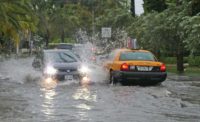Rising Challenge
Discovery of Engineering Failure Leads Miami Beach to Flooding Fix

Miami Beach is elevating roads and adding pump stations as part of a switch to a new stormwater drainage system.
IMAGE COURTESY MIAMI BEACH

Currently, Miami Beach is overseeing construction of Florida DOT’s $25-million Indian Creek/SR A1A project.
PHOTO BY SCOTT JUDY


 After Miami Beach’s Sunset Harbour neighborhood experienced extreme foot-deep “sunny-day flooding” because of a king tide, city engineer Bruce Mowry and public-works director Eric Carpenter realized the city’s injection-well drainage system didn’t work.
After Miami Beach’s Sunset Harbour neighborhood experienced extreme foot-deep “sunny-day flooding” because of a king tide, city engineer Bruce Mowry and public-works director Eric Carpenter realized the city’s injection-well drainage system didn’t work.
The king tide triggered an aha moment for Mowry and Carpenter.
“We finally realized that the injection wells are overwhelmed when the tides are high because the pressure from the tide is pushing back on the well, and you can’t inject water above a certain psi, a certain head elevation, because you don’t want to destabilize the subsurface,” Carpenter says.
Environmental regulators liked the natural filtering system inherent in the 80- to 100-ft-deep injection wells, which didn’t require any pretreatment, according to city officials. But because there was no room for the water in the barrier island’s porous, coarse limestone during high tides, the water simply came back up.
Fairly quickly, the city began looking at the concept of treating stormwater and then releasing it into Biscayne Bay. It was a more costly solution, but one that would work.
Miami Beach is now on a mission to construct around the city about 70 pump stations to pretreat stormwater runoff before discharging it into Biscayne Bay. To date, about 30 pump stations are operational. At the same time, Mowry and Carpenter began looking at elevating some of the city’s most flooded roads.
The city’s first major project, in the Sunset Harbour neighborhood, involved raising what was considered the lowest road in Miami Beach, ultimately elevating it roughly 2.5 ft.
FLORIDA Miami Beach is forecast to experience a sea-level rise of between 0.7 ft and 1.4 ft by 2040.
Waiving the city’s standard procurement process and using instead emergency-directive contracts using design-build delivery, Miami Beach hired Bergeron Land Development, a contractor already mobilized on a DOT contract near Sunset Harbour.
Importantly, says Mowry, much of the design around the existing retail development evolved as a result of input from the local business owners. By building a retaining wall around the development’s northern boundary and transforming what had previously been street parking, contractors and engineers effectively created an outdoor space that local restaurants can use for their patrons, an added value for those businesses.
Further, Miami Beach is raising a road and installing new stormwater and sewer drainage on the A1A state highway. The $25-million Indian Creek Drive/SR A1A Flooding Mitigation project also will establish a linear greenway on the west side of A1A, running along the Intracoastal Waterway, that will serve as a barrier wall for the city. The structure will allow water to flow into and out of its soil structure, effectively acting like an earthen dam, says Mowry.
At roughly 25% completion in early July, Mowry hopes the contractor, David Mancini & Sons, can complete the project in time for this year’s king tide in October. The city is leading oversight of the Florida Dept. of Transportation-funded project.
Overall, the city’s program of raising roads and other infrastructure to the elevated specifications and converting to a new stormwater drainage system should buy Miami Beach from 30 to 50 years, if current sea-level-rise projections are correct.
If those projections are wrong, that’s another story.
How Engineers Are Preparing for Sea-Level Rise






